The image adorning this article is of one of three coaches who have championed counter-pressing and used it to great effect tactically: Jürgen Klopp, Jesse Marsch and Marco Rose. It is, perhaps, of no surprise that the latter two have come through the Red Bull organisation, where Ralf Rangnick has instilled a culture of high-intensity pressing and counter-pressing. This was all inspired by a pre-season friendly against Valeriy Lobanovskyi’s legendary Dynamo Kyiv team back when Rangnick was managing a sixth-tier side in Germany. Now, almost thirty years later, counter-pressing is a well-known tactic and term within modern football.
One of the issues with how many see counter-pressing and, in general, defensive transition is that it is a separate part of the game. Seeing the game as four distinguished parts (five if you include set-pieces): in possession, defensive transition, out of possession, attacking transition (and repeat) can lead to teams entering these moments of the game too slowly.
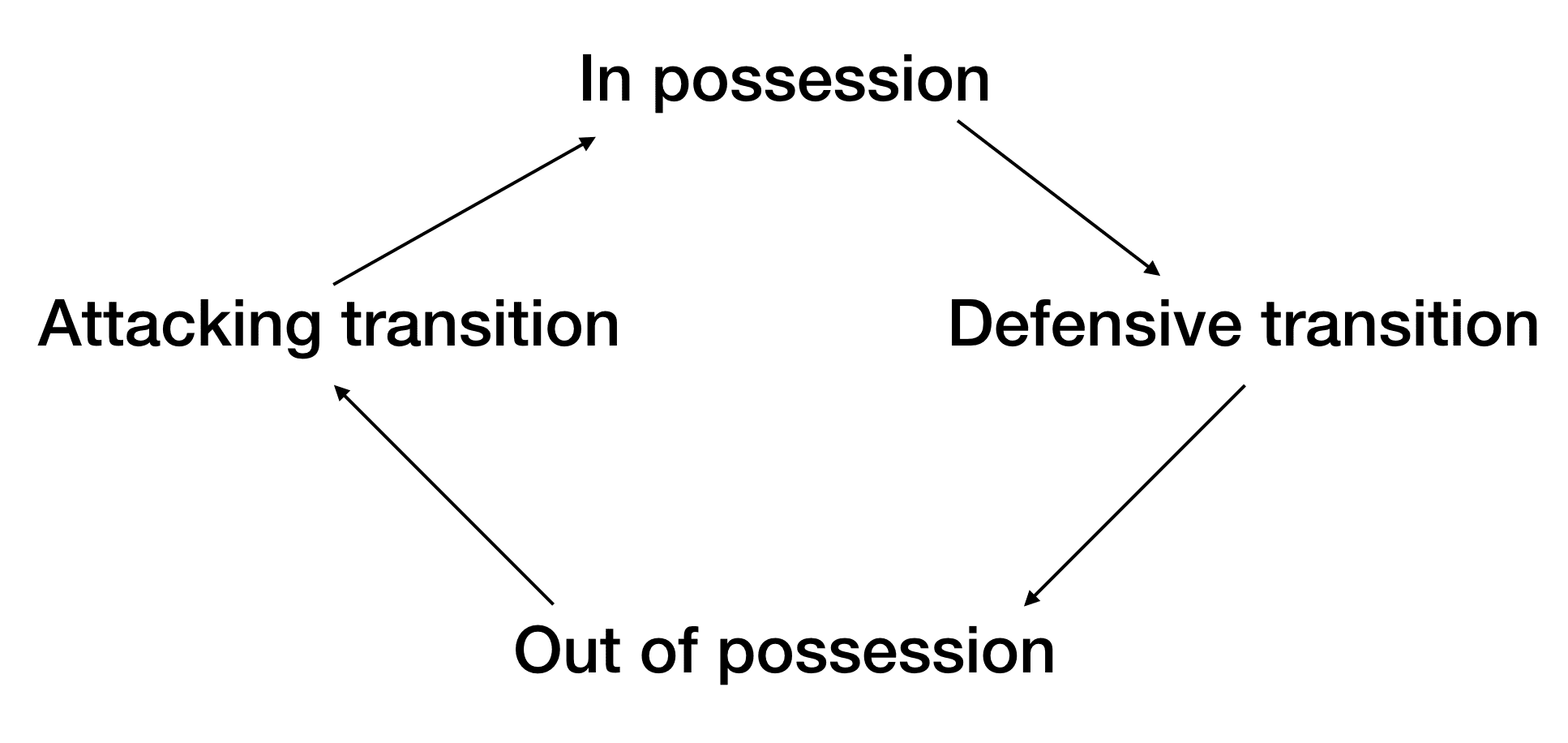
Rather than the graph shown below where all are separate moments, they should be seen as more intertwined, specifically note how in possession and defensive transition are not separate entities. This next graph comes from the great work of Raymond Verheijen, who used it to show how transition should really be viewed by teams in and out of possession.
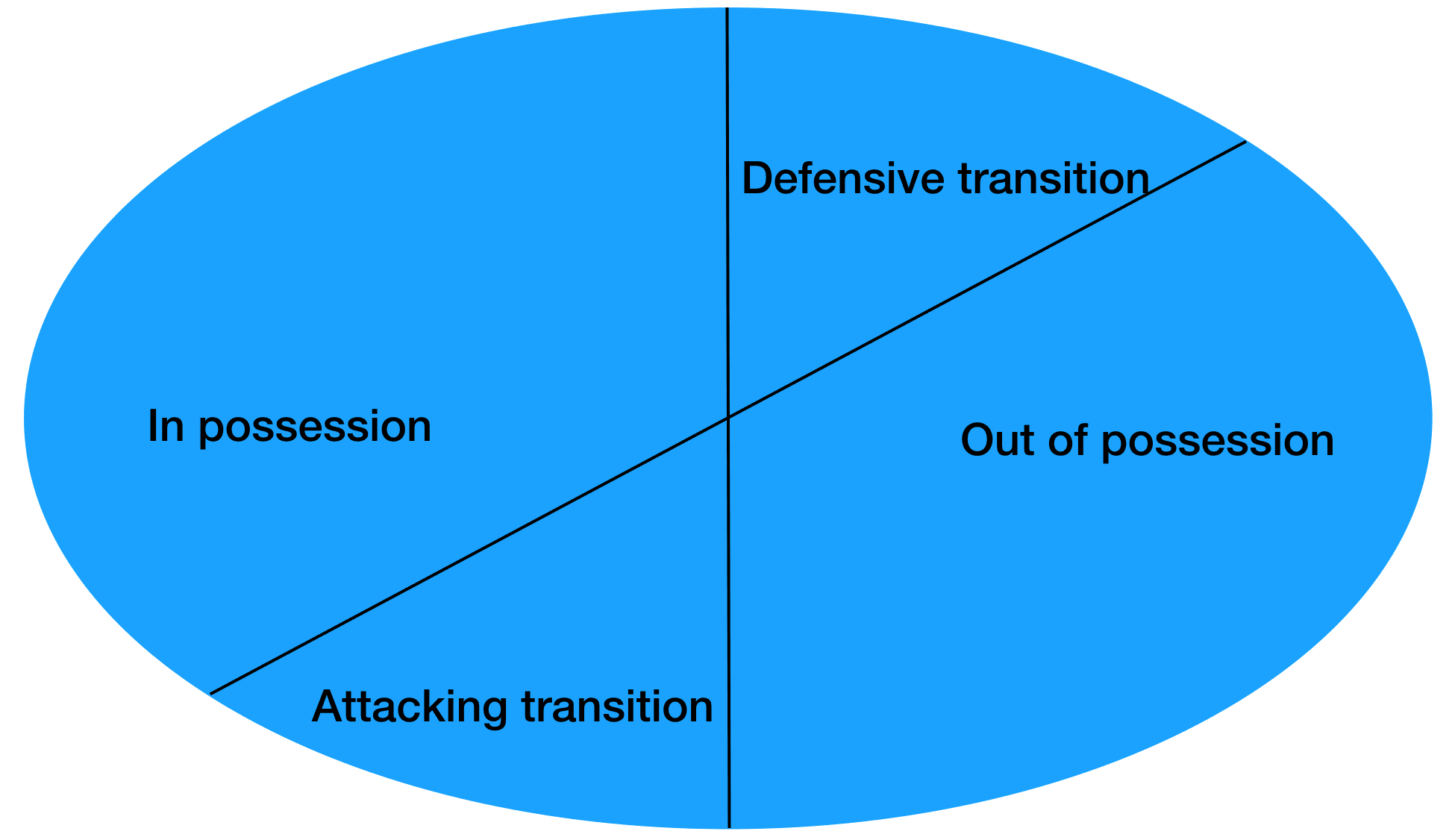
However, firstly, what is counter-pressing?
It is the action of regaining possession in the aftermath of initially losing the ball. It is firstly a way to stifle counter-attacks by the opposition, yet it can also be used as a tool to structure attacks. If the ball can be regained when the opponent is transitioning into attack and that attack is stifled immediately, then the opposition are still in a state of attacking transition and therefore unable to defend the counter-attack.
The first half of this tactical analysis will focus on the topic of counter-pressing and the principles of play surrounding it, whilst providing a brief analysis of some examples of how it is used by Liverpool, Leipzig, and Dortmund.
The second half of this article will focus on coaching this topic, providing a structure for the tactics needed to use counter-pressing effectively.
The principles:
Reaction to the loss of possession
The first part of the counter-press is obviously the initial reaction and effort to regain the ball. Top coaches ask for their players to give full intensity to regain possession as soon as the ball is lost. This is often given a time limit (for players can’t give that intense reaction for an unlimited period of time), with five or six seconds of intense pressure potentially being enough time to attempt an optimal counter-press. The actual specific period of time is relatively arbitrary. Coaches just want their players to give intense pressure for a longer amount of time than just an initial one or two-second effort and, as mentioned, don’t want them going for 10-20 seconds because this just isn’t sustainable.
Two reasons are underpinning the counter-press. The first is that the team want to regain the ball as early as possible. However, the second is that the opposition aren’t set to play instantly upon winning the ball as they would be 10 – 20 seconds into the possession phase. In the first few seconds, the teammates of the ball-winner are transitioning from defence into attack and so aren’t ready to receive the ball. Therefore, an initial counter-press gives the team previously in possession an excellent chance of regaining the ball quickly as the opposition aren’t ready to enter fully into their possession phase.
How many players should counter-press? Well, that is perhaps relative to the situation but also the individual tactics of a coach. Some coaches who are more moderate with their defensive transition tactics may say the player who lost possession and the next closest player should counter-press, whilst others will say anyone in the immediate vicinity should counter-press.
There are more nuances to this though — and this will be looked at in the coaching section of this article in more detail. However, teams will look to dictate where the opposition look to play on transition e.g forcing them inside, but also specifically will want to prevent them finding an outlet pass to get away from the counter-press easily.
Liverpool’s reaction time to a loss of possession is consistently outstanding under Klopp — although that’s unsurprising given the importance of the counter-press to Klopp’s tactics and the fact this is the German’s seventh season in charge of the Reds.
An example of this reaction can be seen from their recent victory away to Watford. The following image shows Mo Salah advancing into the area on the ball before being dispossessed by a Watford defender.
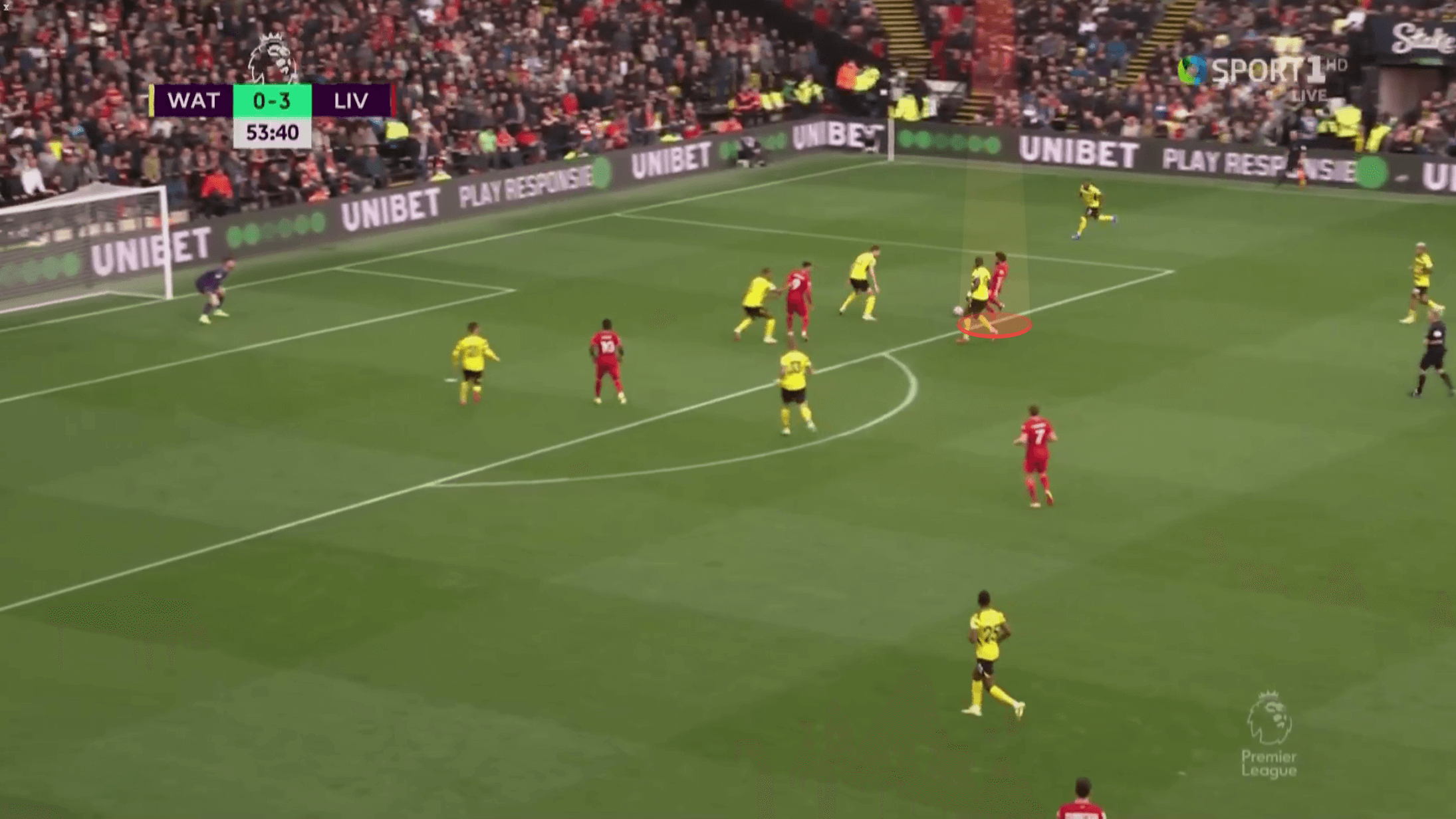
As the Watford defender moves the ball away after the challenge, we can see just how quickly Liverpool’s attackers swarm the ball and create a 5v2 in such a short space, making it incredibly difficult for Watford to retain possession. The Watford attacking transition is thwarted, whilst Liverpool can continue their attack after regaining the ball.
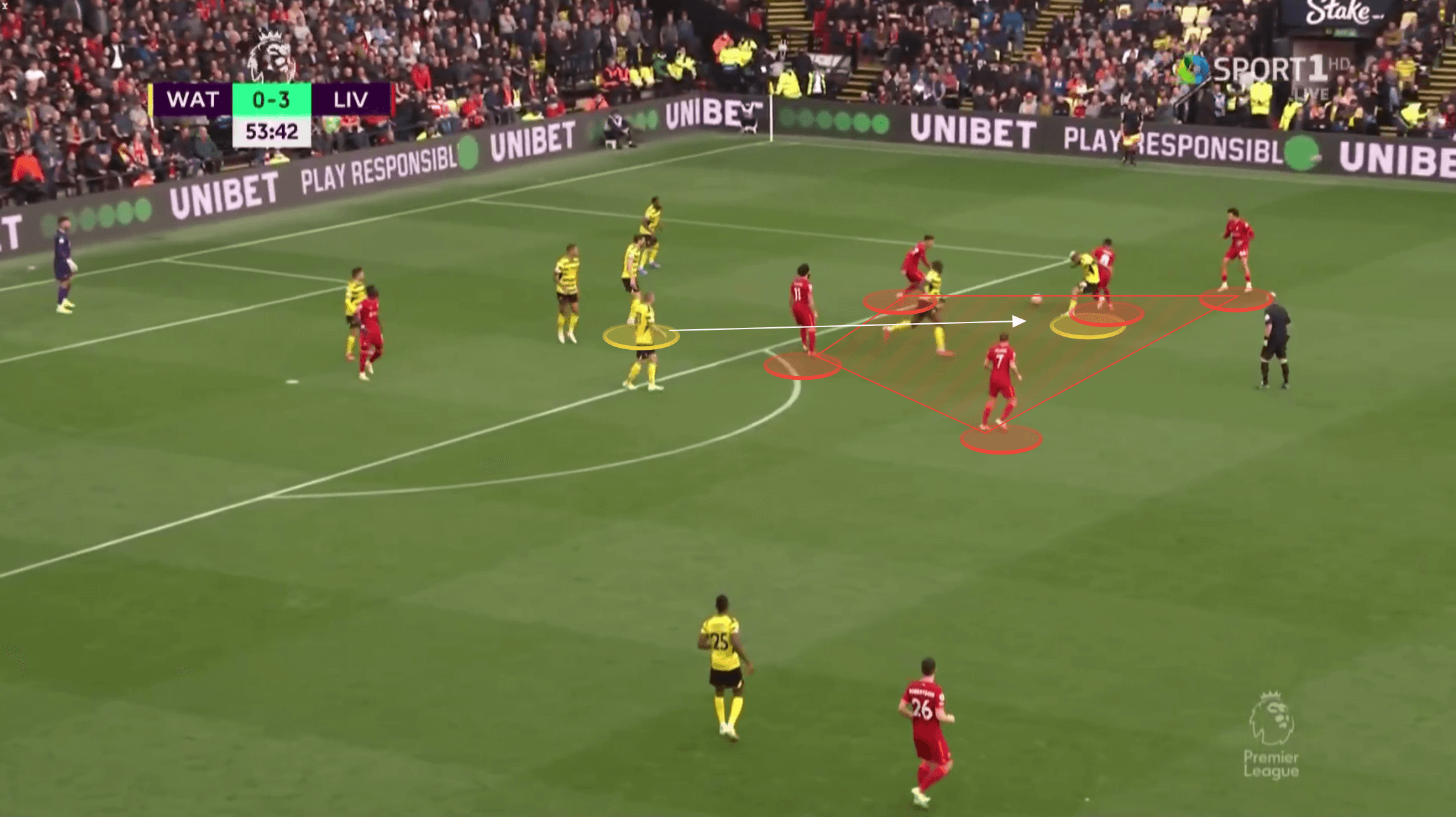
Protect the space
Following the quick reaction to the loss of the ball, the teammates not directly involved in the immediate counter-press need to ensure there isn’t an easy way out of the pressure for the opposition. They need to either mark open players or mark open passing lines. This can either lead to the ball-carrier holding onto the ball for too long or giving the ball away cheaply.
An example of this is shown in isolation in the next image where most of the blue players are man-marking the nearest options for the red ball-carrier whilst this player is being pressed, as one blue player drops deeper to protect the passing line too.
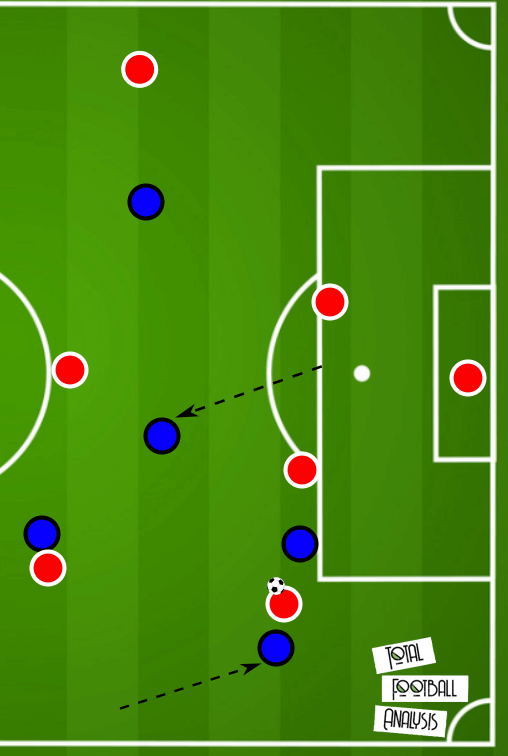
Whilst players have to be switched on and ready for the loss of possession to go and press the opponent, they also need to be aware of potential passing lines.
An in-game example of this is seen in the following two images where Leipzig’s attack is thwarted in the final moments by Bochum.
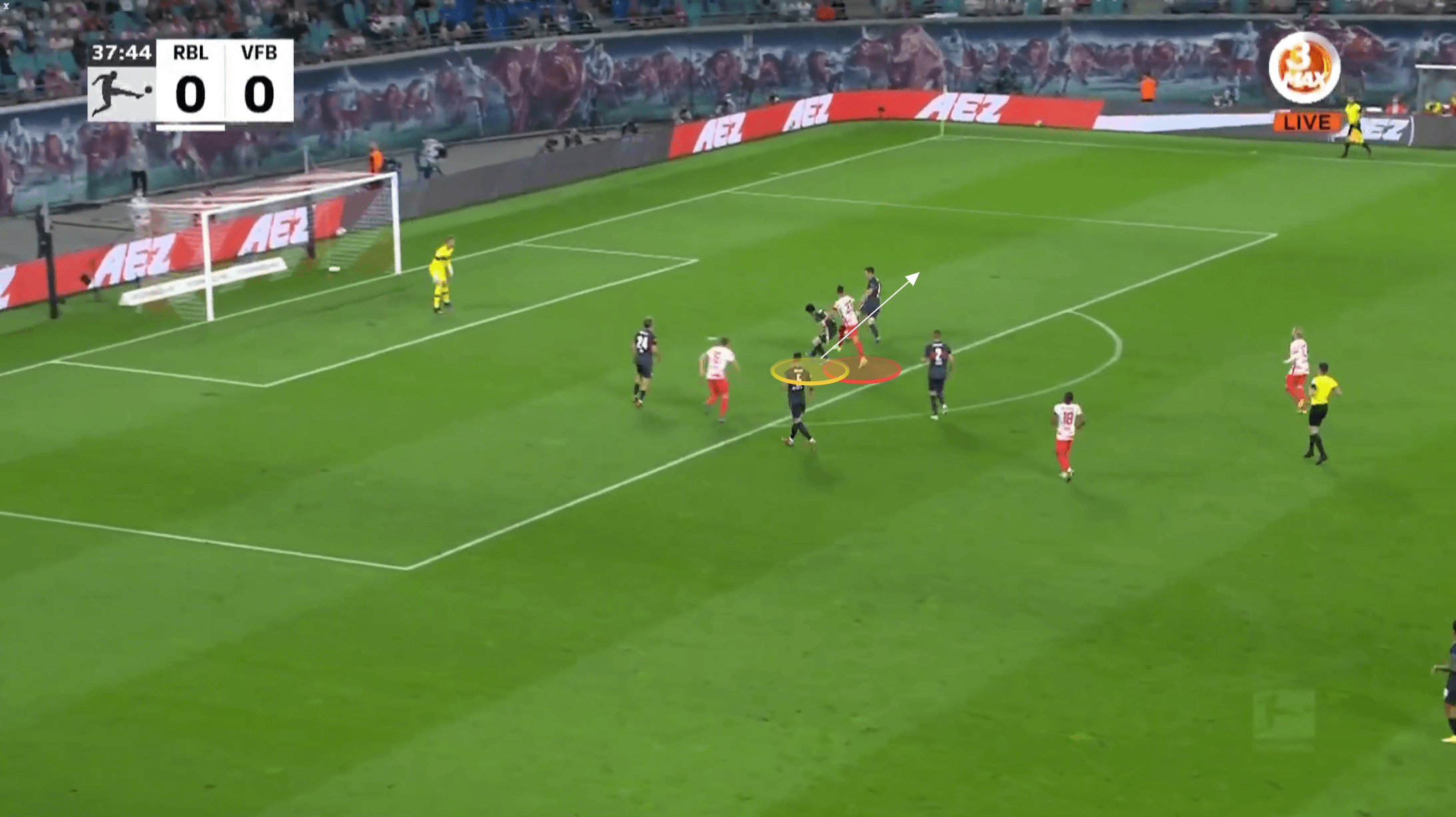
André Silva is the forward in this example who loses possession. He has the speed of reaction to follow the ball and harass the ball-winner, preventing them from having time to pick out a pass. The Bochum player instinctively looks to play the ball to where he believes a teammate is. He doesn’t get his head up properly before playing this pass, focusing on preventing André Silva from winning the ball-back. Off the ball, Dominik Szoboszlai has also shifted across the pitch, anticipating where the ball-carrier is likely to play, and he is able to intercept this pass before driving forward to open the scoring in this game.
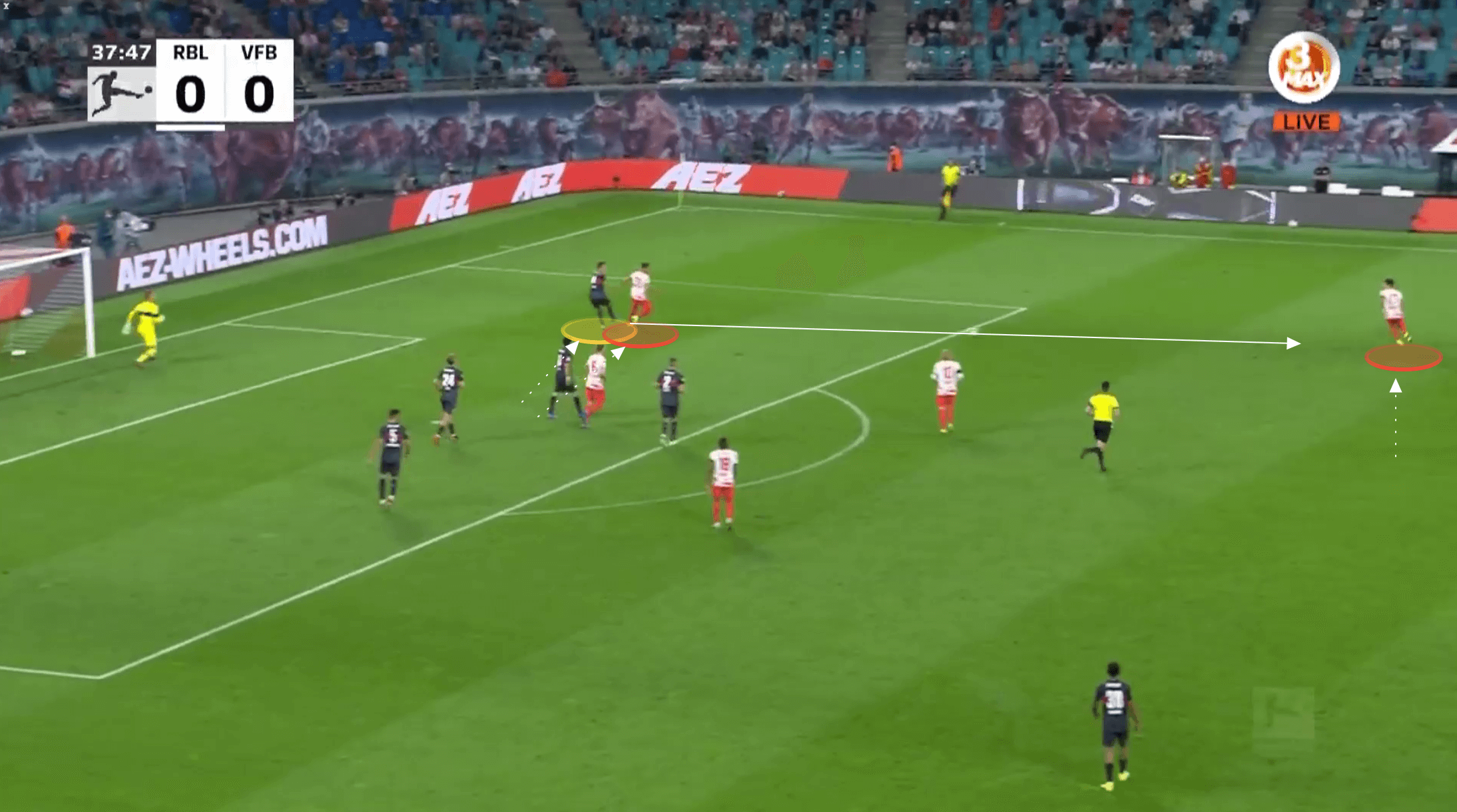
Structure the attack
Before moving on to the second half of the article, the location where the counter-press is used on the pitch should also be noted. This isn’t something that’s occurring regularly inside a team’s own defensive third. Rather, preferably, in a position where an attack can be launched. Counter-pressing can be risky and doesn’t always result in regaining the ball. It is an aggressive ploy to win the ball back, but it does surrender space initially behind the pressing players, and it can lead to big spaces between the midfield and attacking lines, for example.
One way of solving this is to ensure that every player on the pitch is anticipating the counter-press and can replicate the movement of the pressing players to prevent space opening up but this is an ideal world and isn’t realistic every time. Therefore, it is important to counter-press aggressively when there are plenty of players behind the ball. Centre-backs may counter-press, but it is far less likely and instead, if there aren’t players sweeping behind, a player is probably best served to drop back into shape and delay the counter-attack.
However, the location isn’t just about ensuring that if it is unsuccessful, your team isn’t completely out of shape. It is also because it opens up opportunities to score. Counter-pressing is absolutely a way to regain the ball quickly, but it is an attacking tactic — or as Klopp puts it, it is a “playmaker”.
Upon winning the ball, the opposition can transition into an attacking set-up. For example, it could be the case that the full-backs push forward and leave the centre-backs isolated. If the counter-press can be structured in a way where players are ready to push forward quicker than these full-backs can drop back, for example, then it can lead to an attacking overload on the counter. This can be seen in the next image where Dortmund regain possession and immediately have three attacking runners against two Ajax defenders.
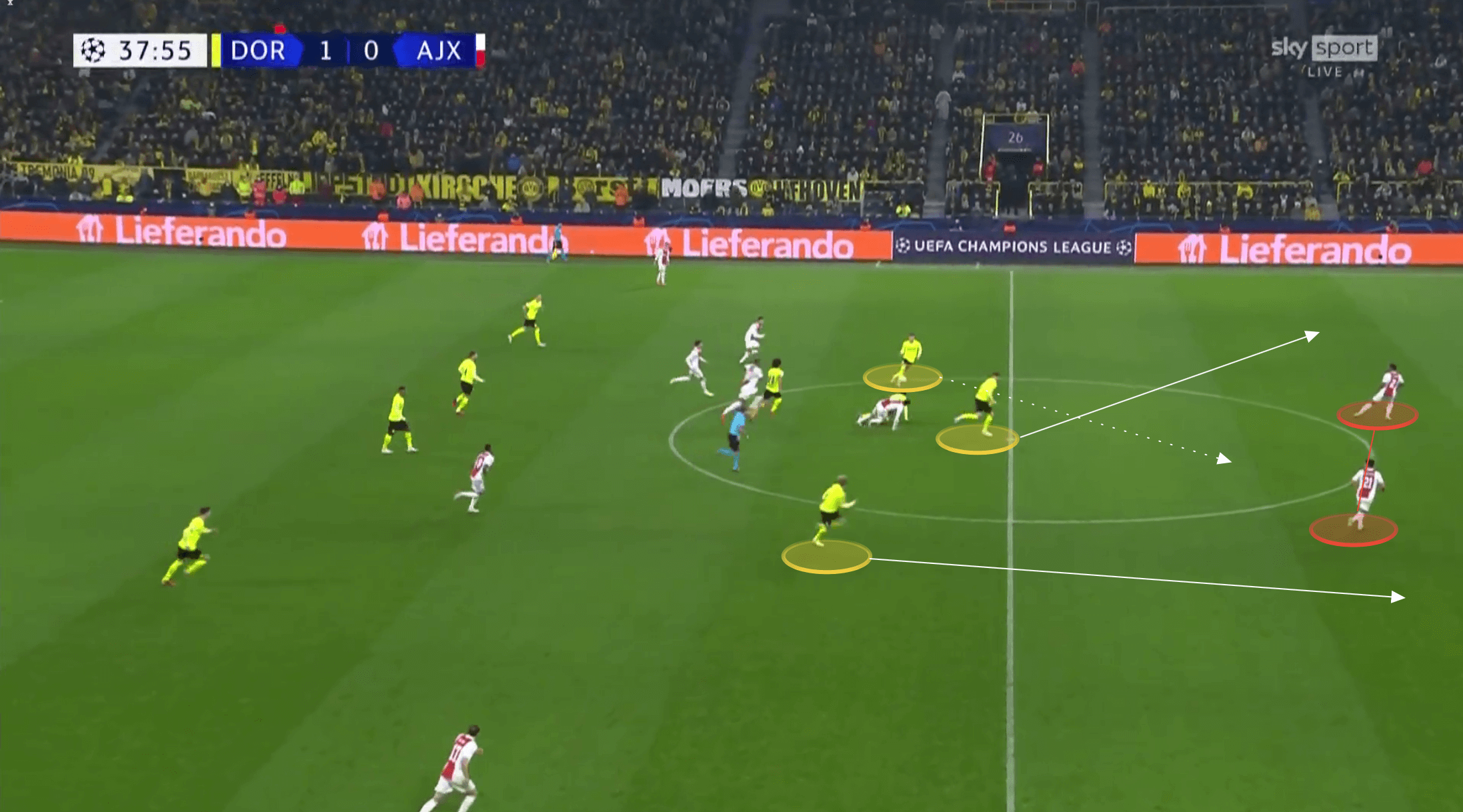
How to coach it
The session shown here is merely an example showing some ideas that could be used, replicated, or played around with in order to coach a session based on counter-pressing. However, going back to the first image in this analysis, counter-pressing is something that can be coached in any possession session as a secondary outcome. The main focus of this session is to use the counter-press to regain the ball, preventing the opponent from entering into the possession phase. A secondary outcome of this session is to use the counter-press to structure attacks.
Part 1:
The first exercise given as an example on how the counter-press could be coached is shown in this section.
The exercise is based around a standard 4v2 rondo; however, this is a 4v2 + 1. We can see how there are two squares, with the red players operating on the lines. They can move up and down the line whilst there are two defenders in the middle.
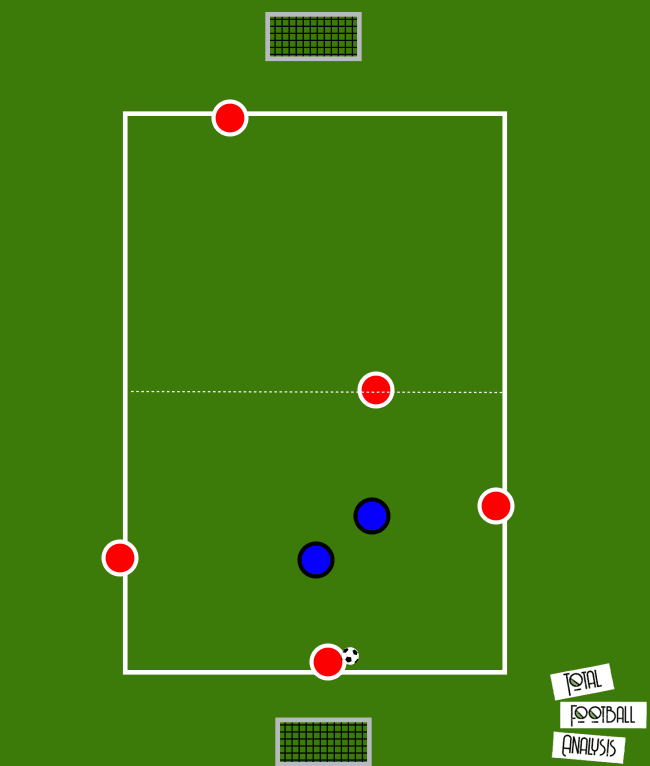
The red player at the top of the rondo is used as a target. If the original four players can work the ball to this player, then the rondo transitions into the second square. This can be seen in the next image.
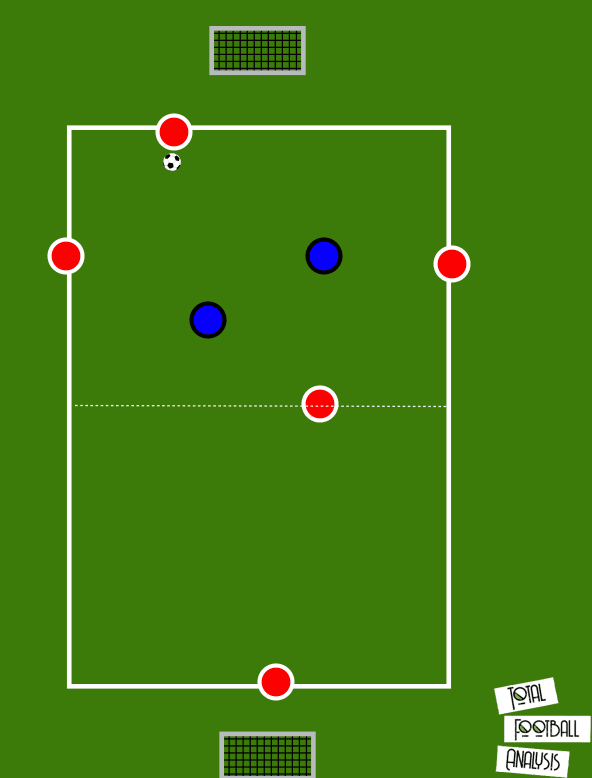
When the blue defenders win the ball, this is where the red players need to spring into action. The blue players will aim to work the ball past the end line before finishing in the closest goal. They must dribble past the end line before scoring in order to give the reds a decent chance to counter-press effectively.
The red players are instructed to react by coming off of their line to counter-press the two blues, quickly creating at least a 3v2. If they can regain the ball, then the practice resumes with them switching the ball as quickly as possible to the second square, getting the ball away from the opponent safely.
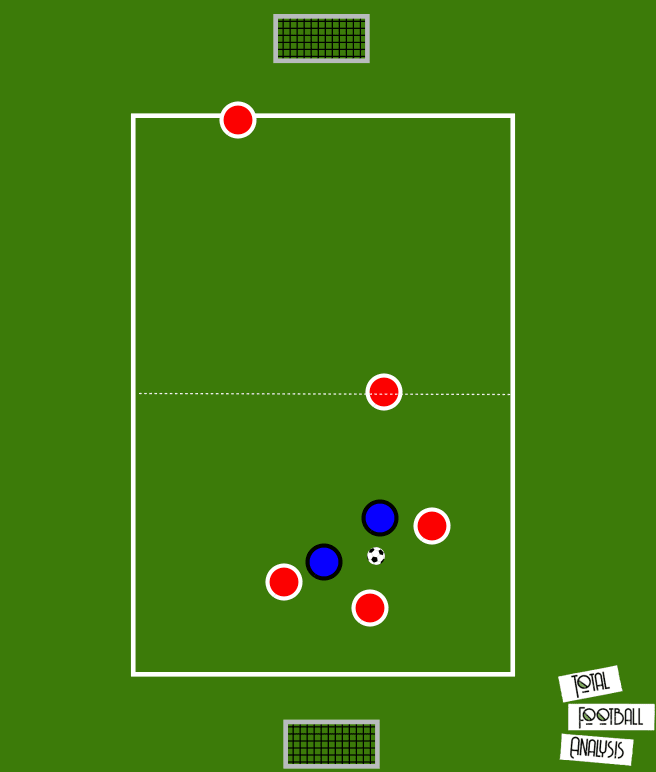
The wide players need to be constantly aware of the potential loss of possession, almost expecting their team to lose the ball. This anticipation is key to ensuring the red at the bottom of the rondo, closest to the goal, isn’t isolated in a 2v1. This player also needs to be quick in pushing forward. If they remain deep they allow the blue team to drive towards them, using their momentum and the red player’s staticity to beat them easily with a dribble. Equally though, they don’t want to get too close too quickly. If the red player is quick to push forward off the line they can close the space, and potentially delay the attack, but if they immediately commit to defending the ball-carrier before the wide red players have tucked inside, then they will isolate themselves in a 2v1. At all times though, this player must also be aware of the location of the goal as they step forward to press.
Part 2:
The next practice builds upon the previous one but adds to the complexity with more variability, more goals for the opponent to score in, and more players. It creates a loss of possession in the central channel with the two reds in the central square representing either a central-midfield or centre-forward pairing. As such, this practice should really be set up in the central channel of the pitch when training. Pitch geography is important in providing context to a session and ensuring they see the link to the game.
The practice starts with the four blues keeping the ball in a 4v2 rondo. Once the reds win possession they can find a player on the outside of the rondo square; these players are instructed to stay on the lines initially, keeping the area wide and stretching the blue counter-press.
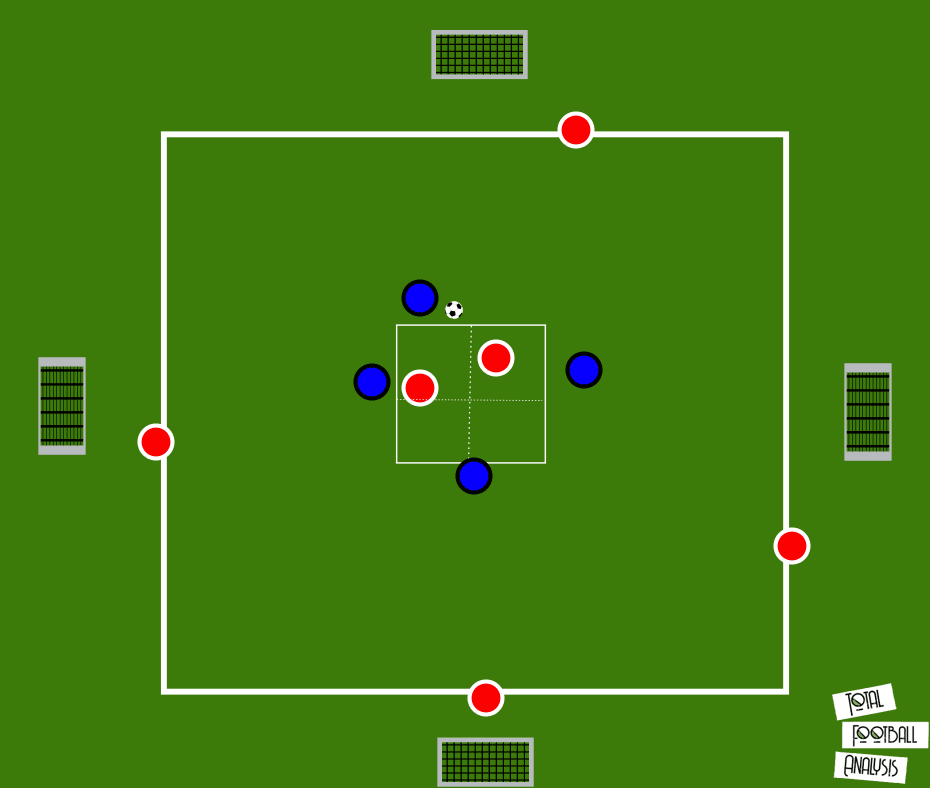
The blue team needs to react to the loss of the ball by counter-pressing and looking to win the ball back from the red team. There should be an initial 5-6 second counter-press, before the blue team enter into a solid block of four, pressing together as a unit at a lower tempo, staying compact and waiting for the red team to make a mistake on the ball.
A useful aside to this practice is dividing the small central square into four mini squares and having the two red players, who are locked into this square when their team have possession, work on their stagger as a duo. As long as they are diagonal from one another, they are offering two different passing lines whilst the stagger is aiding ball progression if the ball is played into this square. They can easily combine before playing back out.
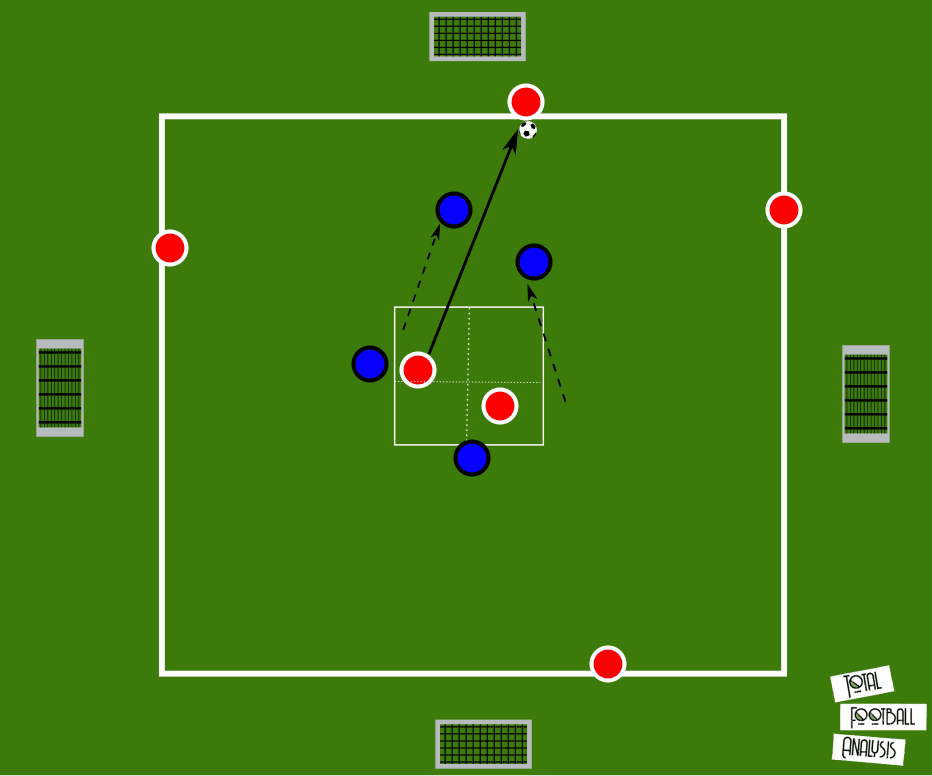
If the blues can win possession, they can score in one of the mini-goals. For the blues, this practice works on the speed of reaction and playing an outlet pass (which the four goals represent) upon winning the ball.
However, the red team can work on counter-pressing too and on the speed of reaction, but also building on the previous practice with regards to getting compact quickly and preventing the team who have won possession from playing away from the counter-press. Now, though, they need to be aware that the opponent has multiple directions in which they can attack. In this practice, it is important to coach the wide players to leave the mini-goals in their cover-shadow as they step forward to press, whilst if the two central players can react to the loss of possession and provide pressure from behind the ball too, it will give the opponent less time on the ball and force them into making a decision quicker.
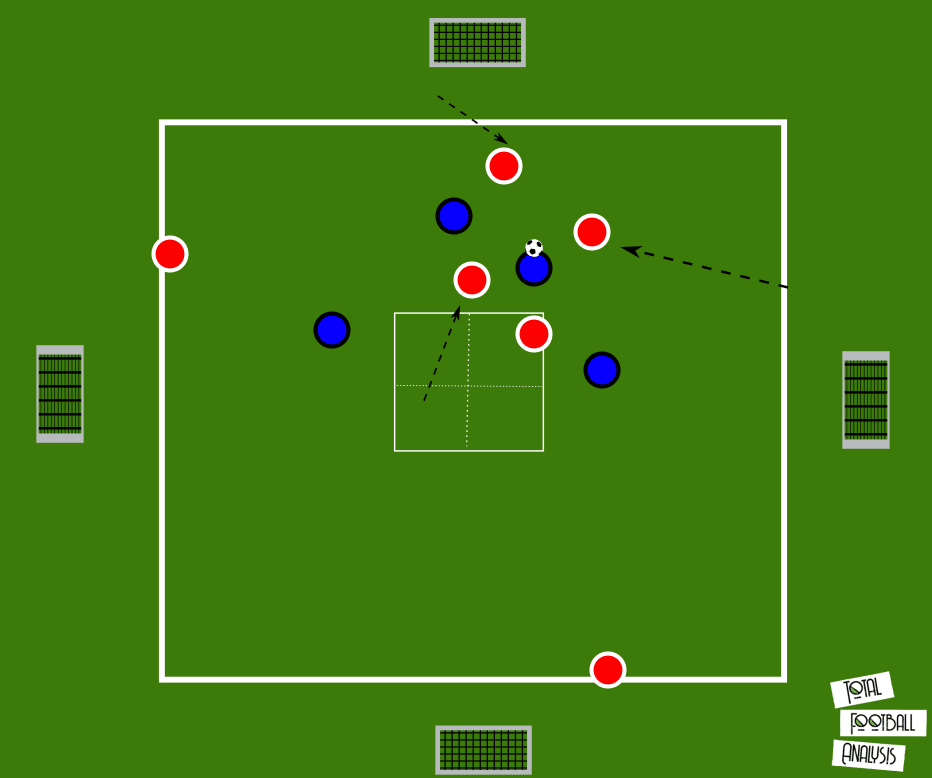
When the red team regain possession, the practice continues. A pass count can be put in place for the red team to give them a goal to aim for e.g eight passes is a goal, whilst the blues are, of course, trying to score in the mini-goals.
Part 3:
Finally, we look to bring this session into a phase of play. The practice can be played on a half-pitch and the numbers or size of pitch for this practice can vary based upon players available. A slight overload can be used for the attacking team to allow them to gain success, within reason, but equally, an even amount of outfield players can work — it depends on the level of the players in the session.
The practice is simple. The red team are looking to score whilst the blue team are looking to regain the ball and score in the mini-goals which represent outlet passes.
The red team in this example have two full-backs, a midfield three, and a front three. Meanwhile, the blue team are operating with a back four and a midfield three.
To prevent the blue team from sitting back — something which could prevent the session from being successful, the defending players can simply be asked to be aggressive. However, an offside line or giving the reds a goal for a certain number of passes on top of being able to score normally is a good way to encourage the defence to look to win the ball early.
If the red team can score a goal from normal play, that is worth one goal. If they can counter-press and win the ball after losing it within six seconds, that is also worth a goal — and any goal coming from the successful counter-press is worth double.
For the blue team, if they score in a mini-goal, that is worth one goal. However, if a full-back can receive in one of the wide boxes after a regain of possession centrally, that is worth a goal too. This will encourage the blue full-backs to push into this area on attacking transition and create the chance for the red counter-press to target the centre-back pair after winning the ball.
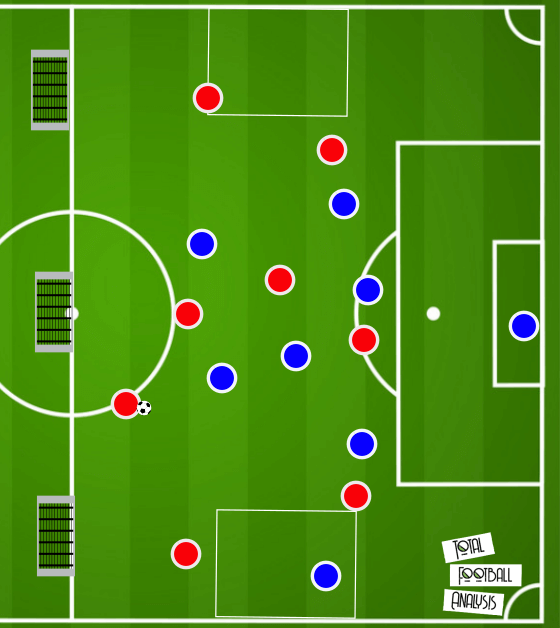
The red team need to be coached to react quickly to the loss of possession, with players in the immediate vicinity counter-pressing whilst players around the ball are either protecting the mini-goals or the wide areas with their cover-shadow. If an assistant coach is at the session, they can coach the blue team and encourage the full-backs to be aggressive on attacking transition and to try to get goals by receiving in this wide area.
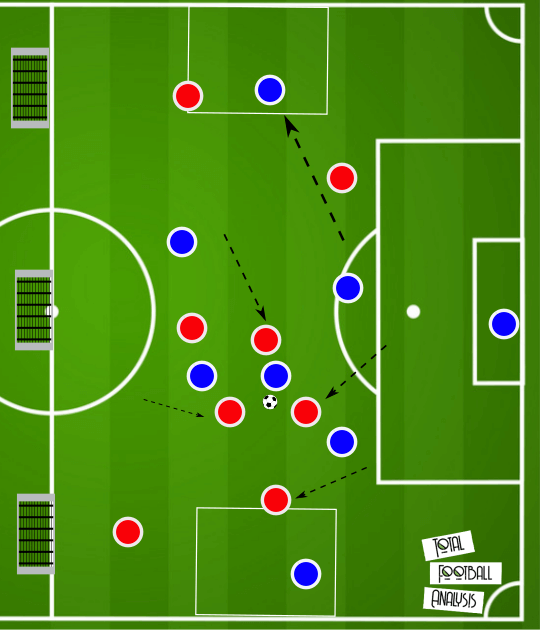
If the front three can begin to understand that they can drop narrow on a loss of possession, or remain in between the opposition centre-back and full-back, then a successful counter-press by their teammates can lead to a chance for the easy counter. The counter-pressing players need to be coached to look for such an opportunity. We can see an example of this in the following image.
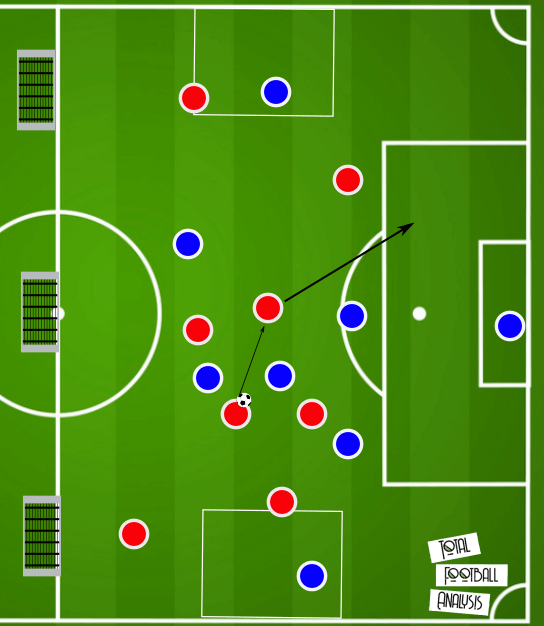
Conclusion
This article aims to highlight some of the key points of counter-pressing. Whilst this session shouldn’t necessarily be copied and pasted — after all, it depends on your game model as to whether this suits your team — it looks to show how a small exercise allowing your players to understand the basic principles of counter-pressing can be built upon and turned into a bigger session in the context of a game.





Comments